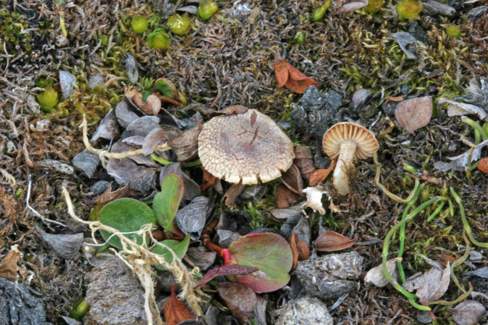 Hebeloma perexiguum (Photo: H. J. Beker)
Hebeloma perexiguum (Photo: H. J. Beker)Taxonomy
Full name: Hebeloma perexiguum Beker, Vesterh. & U.Eberh., Persoonia 35: 137 (2015)Genus: Hebeloma
Section: Denudata
Subsection: Crustuliniformia
Types: SVALBARD: London (78.9631°N, 12.0503°E, alt. approx. 5 m a.s.l.) on soil in arctic tundra under Salix polaris, 18 Aug. 2007, H.J. Beker, M.L. Beker (Holotype. herbarium acc. no. BR-MYCO 173979-58 (holotype), HJB12038).
- arrow_drop_downarrow_drop_upEtymologyFrom per– very and exiguus– small, to emphasise the small size of this mushroom.
- arrow_drop_downarrow_drop_upDiagnosisHebeloma perexiguum belongs based on its cheilocystidium shape to H. subsection Denudata [H. subsection Crustuliniformia]. It can be recognized by the swollen basal part of the cheilocystidia and its small size. It can be recognized from other species of the subsection that are known to occur in arctic/alpine habitats and form small basidiomes, such as H. salicicola by its small number of full length lamellae, which is less than 30, from H. minus and H. pallidolabiatum by its low spore ornamentation (O1), from H. aurantioumbrinum by its spore width being greater than 7 µm and from H. louiseae by its average cheilocystidium apex width of less than 9 µm.
References
Description
- arrow_drop_downarrow_drop_upThresholds
Description of Hebeloma perexiguum based on 2 collections
- arrow_drop_downarrow_drop_upMacroscopic descriptionPileus: (7) 9 (12) mm diameter; shape convex; characters Not recorded; margin characters smooth; viscosity tacky when moist; colour variation unicolour; colour at centre greyish brown.
Lamellae: attachment emarginate; maximum depth not recorded; number of complete lamellae up to 25; presence of tears absent; white fimbriate edge present.
Cortina presence: no.
Stipe: (10) 12 (15) x 2 {median} x 2 {basal} mm; stipe Q 5.0–7.5; base shape cylindrical; floccosity pruinose; rooting no; thick rhizoids at base absent;
Context: Texture firm; stipe interior Not recorded; stipe flesh discolouring weak; slenderness measure up to 8.3; smell Not recorded; taste Not recorded.
Spore deposit colour: Not recorded.
Exsiccata characters: pileus blackening.
- arrow_drop_downarrow_drop_upMicroscopic descriptionSpores: shape amygdaloid; colour in microscope brown yellow; guttules no. papilla yes; Spore Code: O1; P0; D1.
Basidia: 30–42 x 8–10 μm; ave. Q up to 3.9; spore arrangement Not recorded;
Cheilocystidia: main shape clavate, clavate-lageniform or clavate-ventricose, lageniform, spathulate-stipitate or ventricose; special features observed often apical thickening or septa; cheilocystidia ratios: A/M = up to 1.75; A/B = up to 1.45; B/M = up to 1.33.
Pleurocystidia: none seen.
Ixocutis: epicutis thickness (measured from exsiccata) up to 30 μm; ixocutis hyphae width up to 6 μm; ixocutis hyphae encrustation yes; shape of trama elements beneath subcutis angular or thickly sausage-shaped up to 16 μm wide.
Caulocystidia: Similar to cheilocystidia but larger, up to 75 μm.
- arrow_drop_downarrow_drop_upSpore measurements
- arrow_drop_downarrow_drop_upCheilocystidia measurements
- arrow_drop_downarrow_drop_upHabitat and distributionHebeloma perexiguum's preferred habitat appears to be arctic tundra or coastal meadow with soil or moist soil. Across our collections, Hebeloma perexiguum has only been recorded as associating with Salix (family Salicaceae). The growth habit of our collections was scattered.
According to our current collections, the species is found only in Europe. From collector information, it appears collections have been found in the 4.1 Grassland – Tundra (50.0%) and 4.4 Grassland – Temperate (50.0%) IUCN habitats We map from the collector's description of the habitat to the International Union for Conservation of Nature (IUCN)'s definition using a standardised set of rules. Please see this page for a full list of IUCN habitats.. Within Europe all our records are from the North (Svalbard and Finland). Specimens have been collected from 65.7°N to 79.0°N.
- arrow_drop_downarrow_drop_upMolecular resultsThe sequences of the single H. perexiguum collection are not included in any species clade for any of the tested loci and in several cases the species is quite isolated within the tree. Based on the available data, it is likely that the species can be recognized by any of the loci tested.
- arrow_drop_downarrow_drop_upCommentaryGiven the shape of its cheilocystidia, Hebeloma perexiguum clearly belongs to H. subsect. Crustuliniformia. It was most likely not included in the ICGs of Aanen & Kuyper (1999). Of the members of this subsection, it is the species with the most swollen basal part of the cheilocystidium and may be confused with species from H. subsect. Clepsydroida, however, there is no arctic/alpine species in H. subsect. Clepsydroida that is so small. Based on just one collection, this species appears to be readily distinguishable from other species in this subsection, with which it might be confused. These would most likely be H. louiseae, H. minus and H. pallidolabiatum or small examples of H. aurantioumbrinum or H. salicicola. Based on its small number of full length lamellae, less than 30, it is distinguished from alpine forms of H. salicicola. The low ornamentation of the spores will distinguish it from H. minus and H. pallidolabiatum. The wide spores, greater than 7 μm, distinguish it from H. aurantioumbrinum and the cheilocystidium average apex width of less than 9 μm distinguishes it from H. louiseae. Given the small number of collections on which our description is based, it is possible that our description is too narrow, but until more collections of this taxon are recorded we cannot be sure.
Geographic distribution
Phenology
- arrow_drop_downarrow_drop_upAdditional cited collections